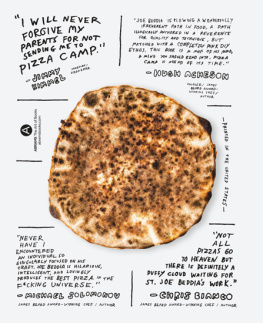Pizza
Notice of Rights
All rights reserved. No part of this book may be reproduced or transmitted in any form by any means, electronic, mechanical, photocopying, recording, or otherwise, without the prior written permission of the publisher.
Notice of Liability
The information in this book is distributed on an "As Is" basis without warranty. While every precaution has been taken in the preparation of the book, neither the author nor the publisher shall have any liability to any person or entity with respect to any loss or damage caused or alleged to be caused directly or indirectly by the instructions contained in this book or by the products described in it.
Trademarks
Many of the designations used by manufacturers and sellers to distinguish their products are claimed as trademarks. Where those designations appear in this book, and the publisher was aware of a trademark claim, the designations appear as requested by the owner of the trademark. All other product names and services identified throughout this book are used in editorial fashion only and for the benefit of such companies with no intention of infringement of the trademark. No such use, or the use of any trade name, is intended to convey endorsement or other affiliation with this book.
Pizza (pronounced 'pi:ts@ ( listen) or English pronunciation: 'pi:dz@; Italian: ['pit.tsa]) is a world-popular dish of Neapolitan origin, made with an oven-baked, flat, generally round bread that is often covered with tomatoes or a tomato-based sauce and cheese. Other toppings are added according to region, culture, or personal preference.
Originating in Neapolitan cuisine, the dish has become popular in many different parts of the world. A shop or restaurant that primarily makes and sells pizzas is called a "pizzeria". The phrases "pizza parlor", "pizza place" and "pizza shop" are used in the United States. The term pizza pie is dialectal, and pie is used for simplicity in some contexts, such as among pizzeria staff.

History
The Ancient Greeks covered their bread with oils, herbs, and cheese. The Romans developed placenta, a sheet of flour topped with cheese and honey and flavored with bay leaves. Modern pizza originated in Italy as the Neapolitan pie with tomato. In
1889 cheese was added.[1]
King Ferdinand I (1751-1825) is said to have disguised himself as a commoner and, in clandestine fashion, visited a poor neighborhood in Naples. One story has it that he wanted to sink his teeth into a food that the queen had banned
Base and baking methods
The bottom base of the pizza (called the "crust" in the United States and Canada)
may vary widely according to style--thin as in hand-tossed pizza or Roman pizza, or thick as in pan pizza or Chicago-style pizza. It is traditionally plain, but may also be seasoned with butter, garlic, or herbs, or stuffed with cheese.
In restaurants, pizza can be baked in an oven with stone bricks above the heat source, an electric deck oven, a conveyor belt oven or, in the case of more expensive restaurants, a wood-or coal-fired brick oven. On deck ovens, the pizza can be slid into the oven on a long paddle called a peel and baked directly on the hot bricks or baked on a screen (a round metal grate, typically aluminum). When making pizza at home, it can be baked on a pizza stone in a regular oven to imitate the effect of a brick oven. Another option is grilled pizza, in which the crust is baked directly on a barbecue grill. Greek pizza, like Chicago-style pizza, is baked in a pan rather than directly on the bricks of the pizza oven.
Pizza types
Neapolitan pizza (pizza napoletana): Authentic Neapolitan pizzas are made with local ingredients like San Marzano tomatoes, which grow on the volcanic plains to the south of Mount Vesuvius, and Mozzarella di Bufala Campana, made with the milk from water buffalo raised in the marshlands of Campania and Lazio in a semi-wild state (this mozzarella is protected with its own European protected designation of origin).[3] According to the rules proposed by the Associazione Verace
Pizza Napoletana [4], the genuine Neapolitan pizza dough consists of Italian wheat flour (type 0 or 00, or a mixture of both), natural Neapolitan yeast or brewer's yeast, salt and water. For proper results, strong flour with high protein content (as used
for breadmaking rather than cakes) must be used. The dough must be kneaded by hand or with a low-speed mixer. After the rising process, the dough must be formed by hand without the help of a rolling pin or other machine, and may be no more than
3 mm (1/8 in) thick. The pizza must be baked for 60-90 seconds in a 485 degC (905 degF)
stone oven with an oak-wood fire.[5]
When cooked, it should be crispy, tender and fragrant. Neapolitan pizza has been given the status of a "guaranteed traditional specialty" in Italy. This allows only three official variants: pizza marinara, which is made with tomato, garlic, oregano and extra virgin olive oil (although most Neapolitan pizzerias also add basil to the marinara), pizza Margherita, made with tomato, sliced mozzarella, basil and extra-virgin olive oil, and pizza Margherita extra made with tomato, mozzarella from Campania in fillets, basil and extra virgin olive oil.
Lazio style: Pizza in Lazio (Rome), as well as in many other parts of Italy, is available in two different styles: (1) Takeaway shops sell pizza rustica or pizza al taglio. This pizza is cooked in long, rectangular baking pans and relatively thick (1-2 cm). The crust is similar to that of an English muffin, and the pizza is often cooked in an electric oven. It is usually cut with scissors or a knife and sold by weight. (2) In pizza restaurants (pizzerias), pizza is served in a dish in its traditional round shape. It has a thin, crisp base quite different from the thicker and softer Neapolitan style base. It is usually cooked in a wood-fired oven, giving the pizza its unique flavor and texture. In Rome, a pizza napoletana is topped with tomato, mozzarella, anchovies and oil (thus, what in Naples is called pizza romana, in Rome is called pizza napoletana).
Types of Lazio-style pizza include:
* Pizza romana (in Naples): tomato, mozzarella, anchovies, oregano, oil;
* Pizza viennese: tomato, mozzarella, German sausage, oregano, oil;
* Pizza capricciosa ("capricious pizza"): mozzarella, tomato, mushrooms,
artichokes, cooked ham, olives, oil (in
Rome, prosciutto raw ham is used and half a hard-boiled egg is added);
* Pizza quattro stagioni ("four seasons pizza"): same ingredients for the capricciosa, but ingredients not mixed;
* Pizza quattro formaggi ("four cheese pizza"): tomatoes, mozzarella, stracchino,
fontina, gorgonzola (sometimes ricotta can be swapped for one of the last three);
* Sicilian-style pizza has its toppings baked directly into the crust. An authentic recipe uses neither cheese nor anchovies. ("Sicilian" pizza in the United States is typically a different variety of product, made with a thick crust characterized by a rectangular shape and topped with tomato sauce, cheese and optional toppings. Pizza Hut's "Sicilian Pizza", introduced in 1994, is not an authentic example of the style as only garlic, basil, and oregano are mixed into the crust);
* White pizza (pizza bianca) omits the tomato sauce, often substituting pesto or dairy products such as sour cream.
Most commonly, especially on the East coast of the United States, the toppings consist only of mozzarella and ricotta cheese drizzled with olive oil and spices like fresh basil and garlic. In Rome, the term pizza bianca refers to a type of bread
Next page















